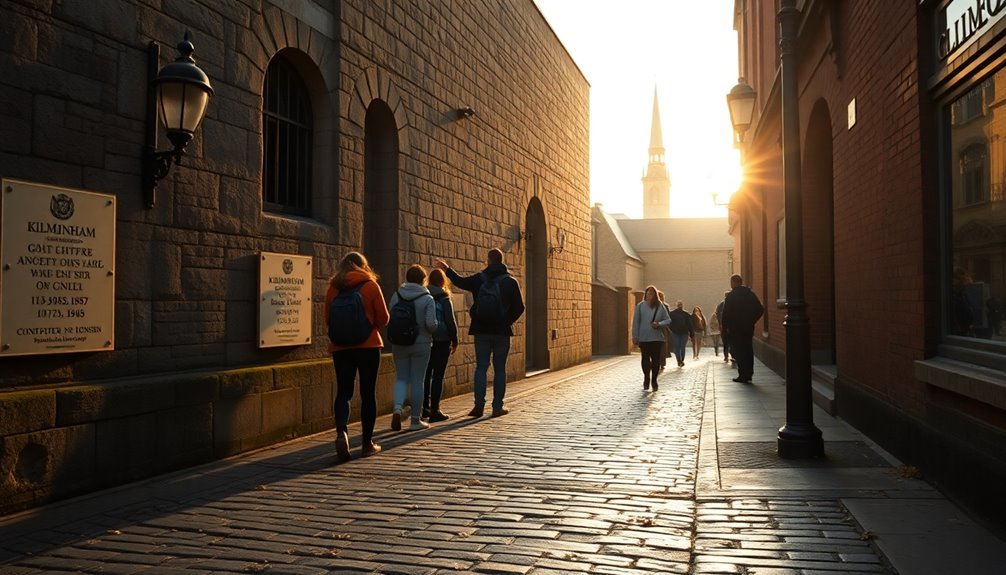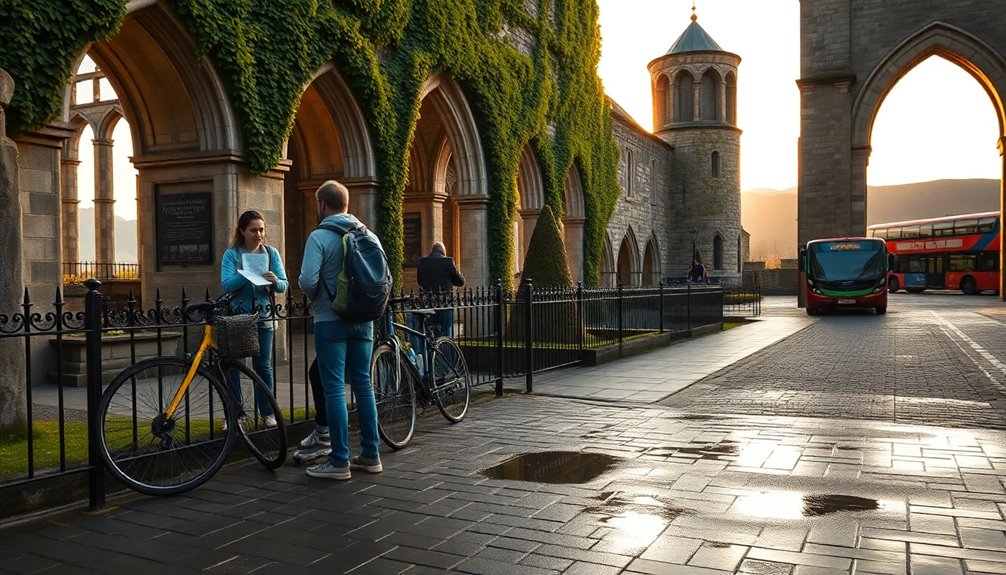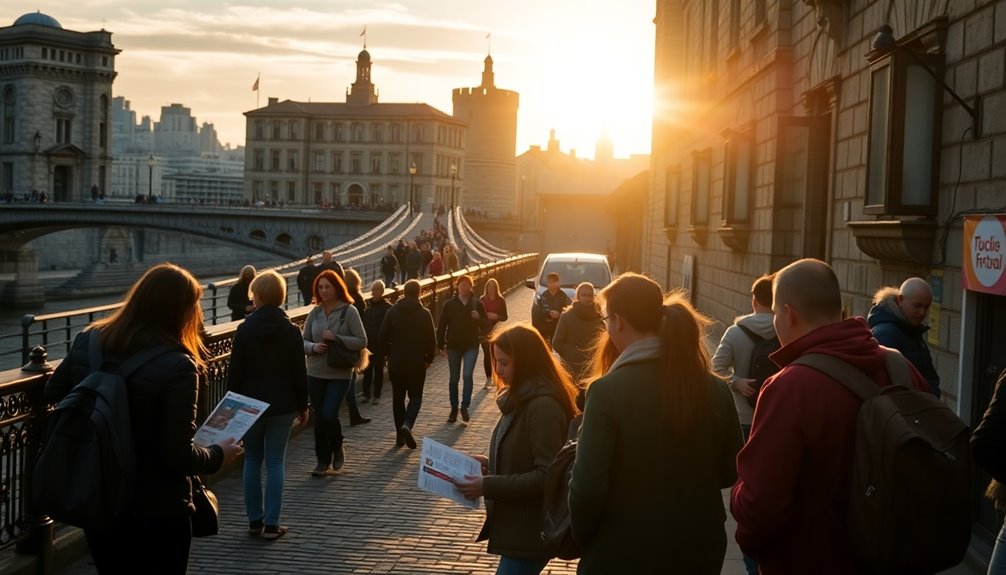
Exploring historical landmarks near Dublin gives you hands-on history that sparks curiosity and sticks with students. Plan logistics, permissions and realistic itineraries with breaks. Choose castles like Dublin, Malahide or Trim for vivid medieval stories, and visit cathedrals and museums with audio guides or workshops. Use public transport, student discounts and packed snacks to keep costs low. Prioritise safety, accessibility and clear roles for chaperones — and keep a few reflective activities ready so you can learn more.
Highlights
- Choose nearby, curriculum-relevant landmarks (Dublin Castle, Trim, Malahide) to connect classroom topics with tangible history.
- Book group rates and guided student tours in advance to secure educational resources and lower costs.
- Plan realistic itineraries with travel times, breaks, contingency plans, and clear meeting points.
- Use public transport, walking routes, and student discounts to keep the trip budget-friendly.
- Prepare safety, accessibility info, consent forms, first-aid, and chaperone roles before departure.
Why Historic Sites Near Dublin Matter for Students
Because walking through a historic site near Dublin brings stories to life, you’ll find those places make classroom lessons concrete and memorable. You’ll connect with cultural significance firsthand, sensing how landscapes shaped lives and ideas. Sites offer diverse educational benefits: active learning, critical thinking, and emotional resonance that books alone can’t supply. You get freedom to explore, question, and form your own interpretations while guided by experts and primary sources. Those experiences deepen empathy, civic awareness, and retention, helping you see history as living context rather than distant fact. Engaging, accessible, and meaningful, these visits enrich both mind and spirit.
Practical Planning Tips for Student Visits
When you’re organising a student visit to a historic site near Dublin, a clear plan will keep the day educational, safe, and stress-free. You’ll map logistics: travel times, meeting points, and contingency plans for weather. Prioritise itinerary planning with realistic durations and breaks so students stay engaged. Brief leaders on group dynamics, roles, and emergency contacts, and share a simple code of conduct with students to protect their freedom to explore responsibly. Pack first-aid, water, and permission slips. Encourage curiosity with a few flexible learning goals rather than rigid schedules, letting the group adapt and enjoy discovery.
Top Castle Tours to Experience
You’ll want to start at Dublin Castle to see its state apartments and medieval undercrofts that bring Ireland’s history to life. Then head north for Malahide Castle, where guided tours and gardens offer hands-on activities and a chance to spot local wildlife. Finally, make time for Trim Castle to explore its imposing keep and learn about the castle’s role in medieval Ireland and film history.
Dublin Castle Highlights
Majestic and surprisingly compact, Dublin Castle sits at the heart of the city’s history and is a perfect starting point for students exploring Ireland’s past. You’ll appreciate Dublin Castle architecture on guided tours that explain Tudor, Georgian, and medieval layers without overwhelming detail. Exhibits and state apartments bring Dublin Castle history to life, showing governance, rebellion, and cultural shifts. You can join audio tours, student-focused guides, or free courtyard visits to suit your pace. Bring curiosity, ask questions, and use the castle as a springboard to nearby museums and walking routes that let you roam freely and learn actively.
Malahide Castle Activities
If you enjoyed the compact storytelling of Dublin Castle, head north to Malahide for a very different castle experience that’s just as student-friendly. You’ll explore Malahide Castle history on guided walks that balance facts with lively anecdotes, and Malahide Castle tours let you roam restored rooms, gardens, and a museum at your own pace. Bring a camera and comfy shoes, join a themed tour or audio guide, and linger in the demesne for picnics or birdwatching. You’ll find friendly staff, budget ticket options, and easy train access—perfect for a curious, freedom-loving student looking to learn without rush.
Trim Castle Exploration
One of Ireland’s finest Norman keeps, Trim Castle invites you to step into living medieval history with hands-on tours, ramparts to climb, and dramatic river views that make its scale undeniable. You’ll explore battlements, learn about Trim Castle’s historical significance, and imagine life inside a fortress that dominated the Boyne. Guides share clear stories about sieges, construction, and daily routines, and you can wander freely to sketch or photograph. Accessible paths and student rates keep visits easy. Pack comfortable shoes, bring curiosity, and let the castle’s atmosphere fuel independent discovery and thoughtful questions about Ireland’s past.
Exploring Medieval Churches and Cathedrals
Although some of Dublin’s medieval churches feel tucked away on narrow lanes, they open a direct window onto the city’s past, and you’ll find their stonework, stained glass, and carved monuments revealing stories of faith, power, and daily life over centuries. You’ll notice medieval architecture details—vaults, lancet windows, and sculpted capitals—that teach construction techniques and social order. Look for plaques explaining historical significance and notable figures linked to each site. Enjoy quiet reflection, sketching, or photography, and respect visiting hours and dress. Guided tours and audio guides can deepen your understanding while leaving you free to explore at your own pace.
Museums With Student-Friendly Exhibits
When you’re looking for hands-on learning, Dublin’s museums deliver exhibits made with students in mind—interactive displays, clear timelines, and activity trails that turn facts into experiences. You’ll find galleries that invite touch, role-play areas that make history personal, and brief panels that respect attention spans. Look for museums offering educational workshops tied to curricula; they often include teacher guides and flexible booking. Choose places that encourage curiosity, let you explore at your own pace, and provide resources for follow-up projects. With smart planning, museum visits become liberating, memorable lessons that empower students to investigate past lives and local heritage.
Walking Routes That Bring History to Life

You can pick short, scenic walking loops that keep energy up and sights close together, perfect for tight schedules and group chats. Choose routes with story-focused stops so each corner or plaque links to a clear episode in Dublin’s past. These walks make history feel immediate and memorable without taking all day.
Short, Scenic Walking Loops
A handful of short, scenic walking loops around Dublin let you soak up layers of history without wearing out your shoes: cobbled lanes, Georgian squares, and riverside promenades link museums, monuments, and stories from Viking Dublin to the Easter Rising. Pick short trail options like the city centre loop through Temple Bar, Trinity and Grafton Street, or the Phoenix Park perimeter for greenery and monuments. These scenic routes are easy to navigate, flexible for spontaneous detours, and perfect for group pacing. You’ll get context, photos, and a sense of place without a rigid itinerary—just freedom to explore.
Story-Focused Route Stops
From scenic loops that show you where history happened, move next to routes that tell the stories themselves—stops chosen so each corner, plaque, or doorway feels like a chapter. You’ll follow storytelling techniques that layer voices, dates, and local lore, so you grasp context without a guidebook. Pick routes with themed stops—rebellion, literature, industry—to connect moments into clear historical narratives you can debate or remix. Carry a notebook, question plaques, and let detours reshape the tale. These routes let you claim the past as yours, learning by moving through places that invite curiosity and independent interpretation.
Outdoor Sites and Archaeological Parks to Explore
While wandering the green outskirts of Dublin, you’ll find outdoor sites and archaeological parks that make history feel immediate — stone forts, monastic ruins, and earthworks where layers of the past are visible in the landscape. You can roam places like the Hill of Tara or Newgrange’s surroundings to sense archaeological significance firsthand, guided trails turning curiosity into outdoor education. Bring sturdy shoes, a map, and an open mind; these sites reward slow exploration and independent thinking. Respect signage and fragile features, take notes or sketches, and let the wide skies and ancient stones give you space to learn and reflect.
Tips for Budget-Friendly Student Travel

If you’re trying to stretch a student budget without missing out on Dublin’s history, a few simple strategies will make your trip both affordable and rewarding. Use public transport passes and bike rentals to cut costs, walk between close sites, and pack snacks to avoid pricey cafes. Scout free-entry days at museums and book timed slots early. Always ask about student discounts at attractions and local shops—carry an ID. Consider off-peak travel and public guided walks for low-cost context. Prioritize what matters to you, mix paid highlights with free experiences, and keep a flexible, curious mindset for true budget travel.
How to Book Group Visits and School Trips
Stretching your student budget is easier when you plan group visits carefully, because coordinating bookings, transport, and discounts can access lower rates and smoother logistics. When arranging a group booking, contact sites early to confirm capacity, educational rates, and any risk-assessment requirements. Assign one lead to handle permissions, payments, and trip logistics so communication stays clear. Compare coach companies and public transport options for flexibility and cost. Ask about free teacher places, guided-visit slots, and storage for bags. Build a simple itinerary with downtime, emergency contacts, and contingency plans — then share digital copies with students and guardians.
Making the Most of Guided Tours and Audio Apps
A good guided tour or audio app can turn a walk past Dublin’s landmarks into a memorable, curriculum-linked lesson — and you don’t need to be a history expert to get the most from them. Choose guided experiences that match your class level and learning goals, then preview stops so you can tie them to lesson plans. Encourage students to explore independently using audio enhancements for self-paced context. Give clear time limits, question prompts, and freedom to follow curiosity within those bounds. Afterward, debrief with quick reflections or creative tasks to cement learning and celebrate discoveries.
Safety and Accessibility Considerations for Students
Because you’ll be responsible for students on busy streets and at crowded sites, planning for safety and accessibility needs to be part of every visit to Dublin’s landmarks. You’ll brief chaperones on clear safety protocols: meeting points, headcounts, emergency contacts, and simple crowd-navigation signals. Check venue accessibility options beforehand—ramps, lifts, quiet rooms—and communicate them to students so everyone feels free to join. Carry basic first-aid supplies, mobile chargers, and paper maps in case of signal loss. Encourage personal responsibility: sensible footwear, weather-appropriate clothing, and staying with assigned groups. That preparation keeps visits smooth, inclusive, and liberating for curious minds.
Combining Cultural Events With Landmark Visits

Plan your visits around event calendars so you can catch talks, reenactments, or music that bring the sites to life. Look for student-friendly programming like discounted tickets, guided tours timed for groups, or interactive workshops that fit class schedules. Combining events with landmark visits makes history more engaging and helps you get more value from your trip.
Event-timed Visits
Nothing beats pairing a landmark visit with a local festival or guided evening tour to bring Dublin’s history to life, and you’ll get richer context while avoiding the crowds that come midday. Plan around event logistics—ticket windows, transport changes, and site opening hours—so your group moves smoothly. Use strict time management: set meeting points, buffer for delays, and cap visit lengths to keep energy high. Choose events that match your curiosity, whether storytelling nights or heritage re-enactments, and you’ll deepen understanding without rigid schedules. You’ll leave with memories shaped by atmosphere, not just facts.
Student-friendly Programming
Pairing an evening festival or guided tour with a landmark visit gives you a great chance to build student-friendly programming that mixes learning with lively cultural moments. You can craft flexible schedules, blend hands-on activities with brief talks, and encourage student engagement through choice and reflection. Prioritize events that highlight historical relevance and invite local storytellers or musicians to deepen context. Keep logistics simple—clear meeting points, transit options, and time buffers—so students feel free to explore. Offer optional quiet moments for processing and easy ways to share impressions afterward, like short digital journals or group debriefs.
Reflective Activities and Project Ideas After Visits
After you’ve explored a site, take a few minutes to guide students in reflecting on what they saw and why it matters—this helps turn a visit into lasting learning. Encourage reflective journaling to capture impressions, questions, and sensory details; give prompts like “what surprised you?” or “whose story was missing?” Pair journals with group presentations so learners synthesize findings and practice public speaking. Offer creative projects—podcasts, photo essays, map redesigns, or short plays—that let students choose how to respond. Conclude with a shared discussion about responsibilities to heritage and how they might act locally, fostering curiosity and autonomy.
Some Questions Answered
Are There Student Discounts for Public Transport to Reach Sites Outside Dublin?
Yes — you’ll find public transport discounts and student travel options for trips outside Dublin. Many operators offer student fares or Leap Card student rates on buses, DART and commuter trains, plus academic-season passes that cut costs. Bring a valid student ID or ASC card for discounted tickets, check operator websites for regional deals, and consider group or off-peak travel to save more. Plan ahead and you’ll travel affordably and freely.
Can Dietary Restrictions Be Accommodated During On-Site Group Catering?
Yes — you’ll usually find on-site caterers can accommodate dietary restrictions. About 60% of groups now request special meals, so ask early. Confirm group menus and specify dietary options like vegetarian, vegan, gluten-free, nut-free, halal or kosher. Provide clear numbers and allergy details, request ingredient lists if needed, and arrange separate labeling or serving times. That gives you flexibility and keeps everyone safe and satisfied.
Are There Quiet Study Spaces at Museums for Follow-Up Work?
Yes — many museums offer study rooms and areas prioritizing museum quietness, so you can do follow-up work without distractions. You’ll usually need to book rooms in advance or check opening hours; some galleries have dedicated study lounges, reading rooms, or quiet corners with seating and Wi-Fi. Policies vary, so contact the museum beforehand about availability, group size limits, and whether food, laptops, or collaborative work are allowed.
What Weather Contingency Plans Do Outdoor Archaeological Parks Have?
About 60% of parks report formal weather preparedness protocols, so you’ll usually find clear plans. You’ll get advance alerts, covered shelters, and flexible outdoor activities schedules; staff monitor forecasts and may reroute tours or pause digs. They’ll advise clothing and gear, provide emergency procedures, and sometimes shift programming indoors. You’ll want to check site-specific policies, sign up for alerts, and carry rainproof layers so your plans stay free and adaptable.
Can Students With Sensory Sensitivities Access Virtual Tour Alternatives?
Yes — you can access virtual accessibility options designed for sensory needs. You’ll find sensory friendly features like adjustable audio levels, captions, low‑stimulus visuals, and guided slower tours. Many sites offer downloadable materials, quiet-mode navigation, and pre-visit orientation videos so you can prepare. Check museum or park websites for accessibility pages, contact staff for accommodations, and choose formats (360° tours, narrated slideshows, or text transcripts) that give you freedom to explore comfortably.
Summing Everything Up
You’ve got a living classroom on your doorstep, so don’t let these sites be mere photos on your phone. Plan realistically, ask questions, and soak up stories—castles, cathedrals, and museums will give your studies depth and spark ideas for projects. Use guided tours or apps to connect dots, stay mindful of safety and access, and treat each visit like a map that leads you to unexpected insights. Reflect afterward to turn visits into lasting learning.
